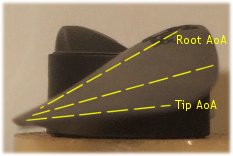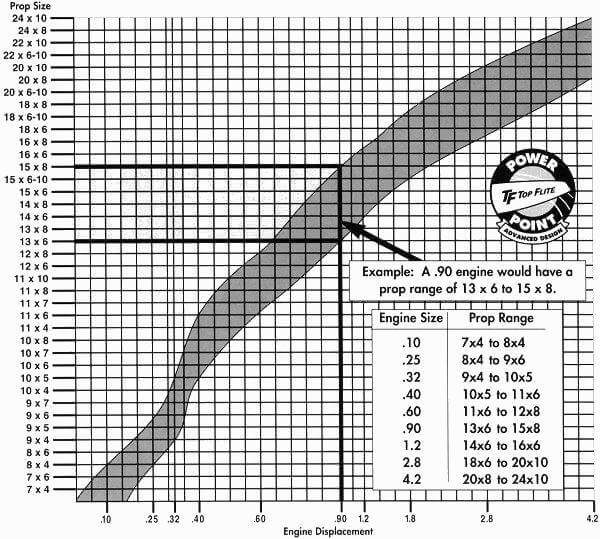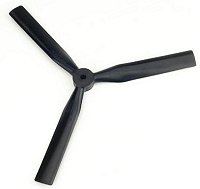Understanding RC Propeller Size
Radio control propeller size selection can be a minefield, especially for the beginner to the hobby, so outlined below are some generally accepted guidelines and recommendations for choosing the right prop for your rc plane.
Selecting the correct propeller for your rc airplane is crucial if you want to get the optimum performance from your plane, regardless of its power type.
In the worst case scenario, the wrong prop can cause serious damage to components and this is especially true for electric powered rc airplanes.
The first and foremost plan of attack is to follow the manufacturer recommendations for the engine or motor that you have. Most engines / motors will come with propeller size information, likely this will be a range of suitable sizes.
RC Plane Prop Basics
You'd be forgiven for just thinking of your rc plane's prop as the thing that pulls the plane along, but understanding a bit about exactly how propellers actually work is no bad thing.
Simply put, props are nothing more than vertically mounted rotating wings. The prop's job is to convert the motor power in to thrust, to pull/push the plane through the air. Thrust is generated in exactly the same way as lift is generated by the wing, and that's why props have a profile airfoil section.
 The 'twist' in the propeller is there to create the essential Angle of Attack of each blade, just like a wing has an AoA. The twist is greater towards the hub of the prop because of varying airspeeds along the length of the blades, and hence varying thrust generation. The picture to the right approximately illustrates how the Angle of Attack varies along the blade length.
The 'twist' in the propeller is there to create the essential Angle of Attack of each blade, just like a wing has an AoA. The twist is greater towards the hub of the prop because of varying airspeeds along the length of the blades, and hence varying thrust generation. The picture to the right approximately illustrates how the Angle of Attack varies along the blade length.
This difference in thrust occurs because the tips of the prop blades move faster than the inner portions of the blades, so the AoA has to change accordingly along the length of the blades; more thrust is generated at faster speeds, just like more lift is generated over a faster moving wing. At slower speed (i.e. nearer to the hub of the propeller), the AoA has to be greater to generate a similar amount of thrust being generated at the faster moving tips.
RC Propeller Size Labelling
All rc propellers are designated two measurements, traditionally given in inches.

The first number is the arc diameter created by the spinning prop i.e. propeller length from tip to tip. The second number is the pitch and this is the harder of the two to understand - but we'll give it a go...
Essentially, diameter determines the 'grunt' and pitch determines the speed of the plane.
Pitch indicates how far, in inches, that propeller will move through the air per single revolution of the engine (i.e. every single complete turn of the prop). However, the pitch measurement must only be taken as a guideline because real-life factors influence the actual distance eg the prop material, its condition, efficiency, air density on the day etc.
So pitch measurement is really only a theoretical value, but it is good enough to help you choose the right size propeller for your airplane's performance requirements.
One way to understand propeller pitch is to imagine the gauge of two different screw threads, coarse and fine, both being screwed into a piece of wood at the same rotational speed. The screw with the coarse thread will cut into the wood faster than the fine threaded screw will.
It's the same for propellers 'cutting' through the air (hence the reason why propellers are sometimes called airscrews).
In the illustration below, the two arrow lines represent the path of each propeller tip. You can see that the higher pitch prop (eg 10x8) takes only one and a half turns to cover the same distance that the lower pitch prop (eg 10x4) takes 3 turns to. So, with both engines and props spinning at identical RPM, and everything else being equal, the higher pitch prop will travel further in the same amount of time - hence a faster flying plane.

So you can see that selecting a different propeller pitch size is going to significantly change your airplane's performance, with speed being the primary factor.
The diameter of the propeller (10" in the example above) will also effect how the airplane flies, but also how the engine runs and, again, following your engine manufacturer's recommendations is the place to start.
Be Noise Aware!
Prop diameter directly influences the amount of thrust generated, but an ever-increasing and non-performance related issue these days, linked to rc airplanes, is that of noise.
A faster turning propeller (and props can easily turn in excess of 10,000 RPM) generates a lot of noise as the tips cut through the air. In fact, when you hear an rc airplane flying it's more than likely the propeller that you're hearing more than the engine.
A larger diameter prop reduces the engine's RPM at any given power setting, because there is more for the engine to turn over and hence more work to do. Slower turning props generate less noise, so larger diameter props run quieter than smaller diameter props, all else being equal.
In this environmentally-sensitive world that we live, this is a serious consideration when selecting a propeller, especially if your flying site is 'noise sensitive' (eg close to houses etc.).
IC Propeller Size Recommendations
As already mentioned, following the prop size recommendations made by your engine manufacturer should always be your first point of reference. But there are generally recognised prop size ranges for each engine size and these are the sizes to choose if you're unsure about propeller selection.
The following propeller size chart (© Top Flight, reproduced with permission) is easy to use; select your IC engine displacement along the bottom scale, then follow the vertical line up to the shaded area to give the prop size range for that engine.

Although this chart is related to Top Flight's Power Point range of props, the size ranges suit all brands.
EP Propeller Sizes
Matching a prop to an IC engine is easy if you follow the general recommendations outlined in the above chart, which have long been accepted in the hobby. Fitting an incorrect prop would mean the engine would still run, but your plane would perform poorly.
But with the advent of electric power (EP), propeller selection became a whole new minefield!
EP prop selection is much more critical because different combinations of motors, ESCs and battery packs can generate huge differences in operating speeds and loads.
As with IC, electric motor manufacturers give a specific propeller size range for their motors but it's more critical that the range is adhered to. Over-propping can do irreparable damage to electric motors and particularly ESCs, because an oversized propeller will force the motor to work harder than it was designed to.
If you put an oversize prop on an IC engine, the engine will likely stop running. No harm done. But put an oversize prop on an electric motor and the motor will just keep on trying to turn the prop.
The motor will draw more and more current as it tries to keep up with its Kv rating (the number of RPM it has been designed to turn, per each volt fed into it). With too big a propeller, the motor will just keep working harder and harder to spin the extra load, until something (likely the ESC) overheats and catches fire.
Too small a propeller on an EP motor won't do any damage, but you won't get the required performance from your plane. The motor will draw less current and the plane will likely be seriously under-powered.
Use a Watt Meter
The only accurate way to know whether or not your EP propeller is resulting in the correct current draw through the ESC is to use a Watt meter connected between battery pack and ESC, as the video below shows...
Watt meters don't cost much money and they are simple to operate; a test takes only a few minutes and will give you solid peace of mind. Personally, if you're an EP flyer, I would say that a Watt meter is as essential as your battery charger!
Number of Propeller Blades
 Most propellers used in the rc flying hobby have two blades, but props with three or even four blades are available.
Most propellers used in the rc flying hobby have two blades, but props with three or even four blades are available.
Two-bladed propellers are commonly used because they are relatively efficient and easy and cheap to produce but sometimes an rc airplane will call for more blades, particularly where a scale look is required.
Adding more blades decreases the overall efficiency of the prop because each blade has to cut through more turbulent air from the preceding blade. In fact, a single blade propeller is the most efficient but these are rarely (almost never!) seen in our hobby although they have been experimented with. A single blade prop must be balanced with a counterweight on the other side of the hub to the blade, otherwise the plane would shake itself to pieces as soon as the prop was turning!
If choosing a three or four bladed propeller over a two bladed one, a very general rule of thumb is to decrease the prop diameter by an inch and increase the pitch by an inch. That said, fuselage and ground clearance issues might dictate which propeller size you can and can't have on your plane. As with everything, trial and error is going to play a part in your propeller selection.
Beware the Biting Prop!
Never ever underestimate the potential for an rc plane propeller to do serious damage.
There are countless stories of model pilots losing fingers, or suffering horrendous lacerations to skin on their hands and arms. Even a small size plastic propeller can hurt and cut skin, so imagine what the bigger ones can do.
Always take great care around a spinning prop and treat it with the utmost respect. Keep hands and fingers well clear and never become complacent.
If you want some gory evidence of what props can do, just Google "rc propeller injuries" and you'll soon see. Keep safe!
Well hopefully this article has given you an understanding of propellers used on rc airplanes, and an idea of how to select the right size propeller for your model.
Remember to follow your engine/motor manufacturer recommendations whenever you can, and use a Watt meter if you are going to experiment with different propeller sizes for EP rc planes.
